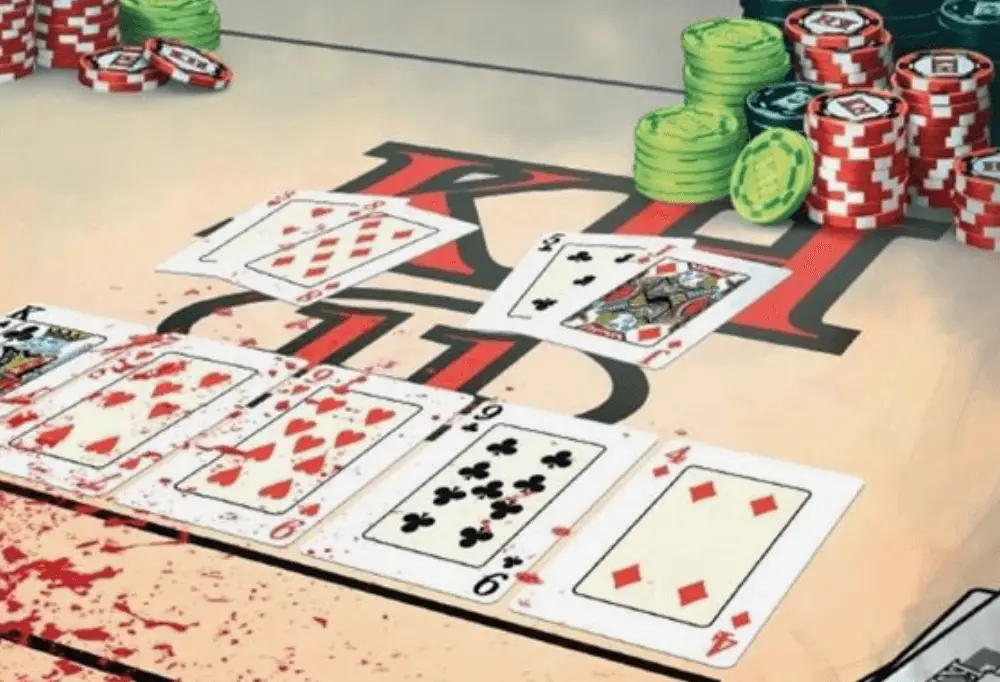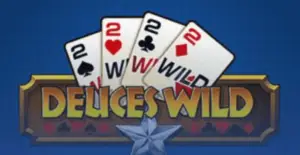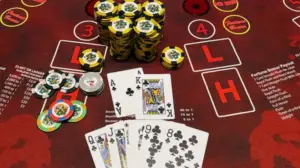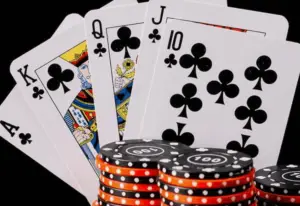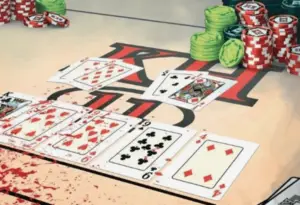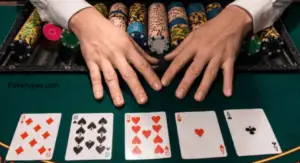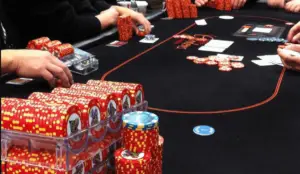Limit Texas Hold’em is a popular poker variant that puts a cap on betting, unlike its no-limit cousin. In this game, players can only bet or raise in fixed increments, which are typically double the big blind.
For example, in a $2/$4 game, bets are $2 pre-flop and on the flop, then $4 on the turn and river.
This structure creates a more controlled and strategic environment, where bluffing is less effective and hand-reading skills are crucial.
While No-Limit Hold’em allows players to bet all their chips anytime, Limit Hold’em requires a different approach, focusing on small edges and consistent play.
Although less popular today, Limit Hold’em still has a dedicated following, especially in cash games and some tournaments. It’s a great way for beginners to learn poker fundamentals without risking their entire stack on one hand.
Game Structure in Limit Texas Hold’em
In Limit Texas Hold’em, the game follows a specific structure with four betting rounds and set betting limits. Let’s break it down:
Betting Rounds
Pre-flop: This is where the action starts. After the dealer gives each player two hole cards, betting begins with the player to the left of the big blind.
Flop: The dealer puts three community cards face-up on the table. Another round of betting follows.
Turn: A fourth community card (also called “Fourth Street“) is dealt, followed by more betting.
River: The final community card (or “Fifth Street“) is dealt, with a last round of betting.
Betting Limits
In Limit Hold’em, you can’t just throw all your chips in whenever you want. There are rules:
Small bet: This is used pre-flop and on the flop. It’s usually the same as the big blind.
Big bet: This comes into play on the turn and river. It’s double the small bet.
Let’s say you’re playing a $2/$4 Limit Hold’em game. Here’s how it works:
Pre-flop and flop: Bets and raises are in $2 increments
Turn and river: Bets and raises jump to $4 increments
Examples in Action
Imagine you’re at a $3/$6 Limit Hold’em table. The blinds are $1.50 (small) and $3 (big). You’re dealt pocket aces – nice! Here’s how it might go down:
Pre-flop: You can bet or raise in $3 chunks. So if someone bets $3, you can raise to $6.
Flop: Let’s say the flop comes A♠7♣2♦. You’ve hit your set! Betting is still in $3 increments.
Turn: The turn is 9♥. Now, bets and raises jump to $6. If someone bets $6, you can raise to $12.
River: The river brings K♦. Betting stays at $6 increments..
Rules and Gameplay
Hand Rankings
In Limit Hold’em, the hand rankings are the same as in other poker games. Here’s the pecking order, from best to worst:
- Royal Flush: The cream of the crop! It’s A, K, Q, J, 10, all in the same suit.
- Straight Flush: Five cards in a row, all in the same suit.
- Four of a Kind: Four cards of the same rank.
- Full House: Three of a kind plus a pair.
- Flush: Any five cards of the same suit.
- Straight: Five cards in sequence, but not all the same suit.
- Three of a Kind: Three cards of the same rank.
- Two Pair: Two different pairs.
- One Pair: A single pair of cards of the same rank.
- High Card: When you’ve got nothing else, your highest card plays.
Remember, in Texas Hold’em, you’re trying to make the best five-card hand using any combo of your two hole cards and the five community cards.
Betting Actions
In Limit Hold’em, you’ve got three main moves:
Call: Match the current bet. It’s like saying, “I’m in, but I’m not raising the stakes.”
Raise: Increase the bet. In Limit Hold’em, this is always a fixed amount. For example, in a $2/$4 game, you’d raise by $2 pre-flop and on the flop, and by $4 on the turn and river.
Fold: Throw in your cards and say “sayonara” to the hand. You’re out, but you’re not losing any more chips.
Betting Caps
Here’s where Limit Hold’em gets its name. There’s a cap on how crazy the betting can get:
- Usually, there’s a maximum of three or four raises per betting round.
- Once the cap is hit, players can only call or fold.
For example, in a $2/$4 game:
- Pre-flop and flop: The most you could bet is $8 ($2 + $2 + $2 + $2).
- Turn and river: The max bet jumps to $16 ($4 + $4 + $4 + $4).
This cap keeps things from getting too wild. It’s like having a speed limit on the Poker Highway!
Strategy Considerations in Limit Texas Hold’em
1. Position Importance
Your seat at the table can make or break your game. Here’s the lowdown:
Early Position
Being Under the Gun (UTG) or close to it is tough. You’re flying blind, not knowing what other players will do. Here’s how to handle it:
Play tight: Stick to premium hands like big pairs and strong Ace-high hands.
Be ready to fold: If someone raises, don’t be afraid to let go of marginal hands.
For example, in a $2/$4 game, you might only play about 15% of hands from early position.
Middle Position
Things get a bit easier here. You’ve seen some action and can make better decisions:
Widen your range: You can play more hands, like suited connectors.
Pay attention: Watch how early position players act to guide your decisions.
In middle position, you might play around 20-25% of hands.
Late Position
This is where the magic happens! Being on the Button or Cut-off gives you a huge advantage:
- Play aggressively: You can steal blinds and play a wider range of hands.
- Control the pot: You get to act last, giving you more control over the hand’s size.
Pro players often play 40% or more of their hands from late position.
2. Starting Hand Selection
Choosing the right starting hands is crucial in Limit Hold’em:
Premium Hands
These are your bread and butter:
- Big pairs: AA, KK, QQ
- Strong Ace-high: AK, AQ
- Broadway cards: KQ, QJ suited
Play these hands aggressively from any position.
Speculative Hands
These hands can win big pots but are trickier to play:
- Small pairs: 22 to 66
- Suited connectors: 78s, 89s
- Suited one-gappers: J9s, T8s
Play these more often from late position or in multi-way pots.
3. Post-Flop Play
After the flop, it’s time to put your plan into action:
Continuation Betting
This is when you bet after raising pre-flop:
- On dry boards: Bet most of the time to take down the pot.
- On wet boards: Be more cautious, especially out of position.
For example, if you raised with AK and the flop comes K-7-2 rainbow, a continuation bet is usually a good play.
Drawing Hands
When you’re chasing a straight or flush:
- Calculate your odds: Know how likely you are to hit your hand.
- Consider pot odds: Make sure the potential win justifies the call.
Let’s say you have 9♥8♥ on a flop of Q♥7♥2♣. You’ve got 9 outs to hit your flush. With two cards to come, you’re about 35% to hit your hand.
4. Pot Odds and Implied Odds
This is where math meets poker:
Calculating Profitability of Calls
To figure out if a call is worth it:
- Count your outs
- Calculate your odds of hitting
- Compare to the pot odds
For example, if there’s $20 in the pot and your opponent bets $5, you’re getting 5:1 pot odds. If your odds of hitting are better than 5:1, it’s a profitable call.
Implied odds take it a step further. They consider how much you might win if you hit your hand. In Limit Hold’em, implied odds are less important than in No-Limit, but they still matter.
Pros and Cons of Limit Texas Hold’em
| Advantages | Disadvantages |
| Reduced Variance | Limited Bluffing Opportunities |
| – More stable bankroll | – Can’t use big bets to force folds |
| – Lower risk of going bust | – Harder to push opponents off hands |
| – Better for beginners | – Less room for creative play |
| – Example: In a $2/$4 game, max loss per hand is typically capped at $48 | – Example: Can’t overbet the pot to represent a strong hand |
| Emphasis on Fundamental Skills | Smaller Pots Compared to No-Limit |
| – Focuses on hand selection | – Lower potential for big wins |
| – Improves pot odds calculations | – Slower bankroll growth |
| – Rewards consistent play | – Less exciting for some players |
| – Example: Playing 20% of hands from early position vs 40% from late position | – Example: Average pot in $2/$4 limit might be $40-$60, while in $1/$2 no-limit it could be $100+ |
Tournament vs. Cash Game Differences
Tournaments and cash games are like night and day in the poker world. In tournaments, the blinds and antes keep climbing, putting the pressure on players to stay in the game.
For example, in the World Series of Poker Main Event, blinds might start at 100/200 chips and double every two hours.
This forces players to get in on the action or risk being blinded out. On the flip side, cash games keep things steady.
If you sit down at a $2/$5 No-Limit Hold’em table, those blinds aren’t budging. This consistency lets players settle into their groove and play their own style. In tournaments, you’re racing against the clock and the rising blinds.
In cash games, it’s more like a marathon where you can take your time and pick your spots. Both formats have their own flavor, and mastering each takes different skills.
Whether you prefer the adrenaline rush of tournaments or the steady grind of cash games, there’s a seat at the table for you!
Advanced Concepts
In the world of poker, being able to read opponents and adjust to table dynamics is like having a superpower. When it comes to betting patterns, keep your eyes peeled for players who always bet big with strong hands or those who get fidgety when bluffing.
Physical tells can be a goldmine too – a player suddenly sitting up straight might have just hit their hand. But don’t put all your chips in one basket; these signs can be tricky to read.
Now, let’s talk about table dynamics. If you’re at a tight table where everyone’s playing like they’re guarding Fort Knox, it’s time to loosen up and steal some pots.
On the flip side, at a loose table where chips are flying like confetti, tighten up and wait for premium hands.
And if you’re up against aggressive players who bet like there’s no tomorrow, be ready to trap them with strong hands. Remember, adapting is the name of the game.
As Fedor Holz, a poker whiz, says, “Without the right starting point, it becomes increasingly likely to veer off course”.
So, keep your eyes open, your mind sharp, and your strategy flexible. That’s how you’ll come out on top in this game of wits and cards!
Conclusion
Limit Texas Hold’em is a game of skill, strategy, and patience. We’ve covered the nuts and bolts, from betting rounds to hand rankings, and dived into advanced concepts like reading opponents and adjusting to table dynamics.
Remember, success in this game isn’t about hitting home runs; it’s about consistently making the right calls. As Daniel Negreanu, a poker legend, once said, “Small edges create big advantages.”
But here’s the kicker: all the knowledge in the world won’t make you a champ overnight. You’ve got to put in the hours at the table, learn from your mistakes, and keep honing your skills.
So, grab a seat, shuffle up, and deal. With practice and persistence, you’ll be raking in those pots in no time. Good luck, and may the flop be with you!
